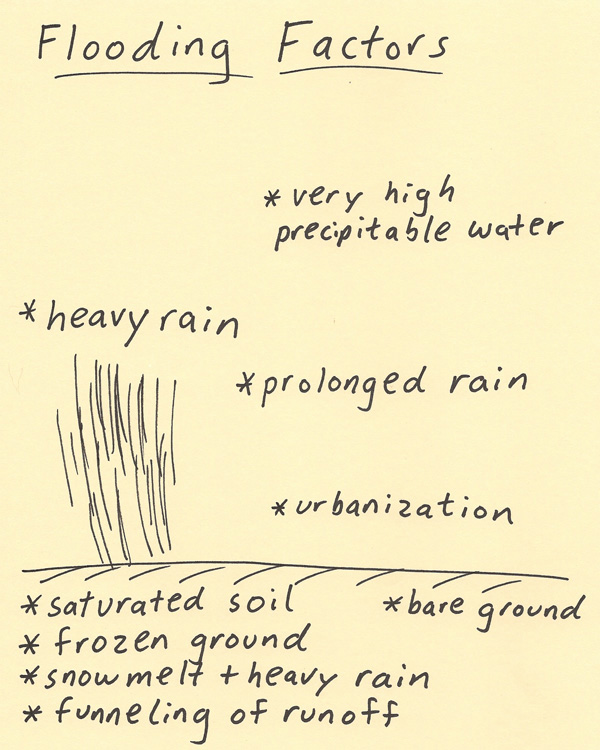
Floods can occur locally or over large regions influenced by a flood plain. They can result in devastating damage and property loss. This writing goes over the factors that cause floods. There are basically four types of floods which are flash floods (convective storm flooding), synoptic storm floods (rain for mid-latitude storm systems), river floods (flooding of a major river system and its tributaries such as the Mississippi River), and a category that for now can be called other types of floods. Below are the factors that produce flooding and how they are caused: Heavy rain: On the local scale, very heavy rain from a convective storm can produce a flash flood. The rain falls faster than runoff can safely get rid of the water. Torrents of destructive water can develop from these heavy rains which can wash out roads, flood streets and turn small streams into raging waterways. On the synoptic scale, heavy rains can produce floods over a large area. Rains from a tropical storm or stalling mid-latitude cyclone can cause tremendous flooding. A flood can occur just about anywhere when the volume of rain falling is high enough. High Precipitable Water: This is an index that indicates the potential amount of moisture in the air. Basically, it is found by summing the moisture in the troposphere. High values indicate a higher potential for flooding, especially if the value of the precipitable water for a location is very much above normal. For example, if precipitable water is 300% above climatological normal then that indicates there is 3 times as much moisture in the air than is typical for that location. Storms developing in this environment have a higher probability of producing flooding. Prolonged Rain: Rain is very good as long as it is enough to provide the ground and vegetation with adequate moisture. If it continues to rain for an extended time then the ground and vegetation will reach the carry capacity for moisture which indicates the ground and vegetation are no longer able to absorb more moisture. Thus, when it continues to rain in this situation much of the rain will flow as runoff. Once the ground is saturated, it does not take as much rain from that point on to produce flooding. Urbanization: Urbanization is the introduction of streets, parking lots, businesses and homes to an area. Rain is not able to absorb into these structures like it does into the porous ground. There is also less vegetation to take up the moisture. The result is that it does not take as much rain to produce flooding. Good sewer systems are vital to getting rid of the rain water that falls but if it rains too hard or the sewer system gets clogs up, then urban flooding can occur. Saturation soil: Saturated soil no longer is able to store the moisture that falls. Thus, additional rain results in runoff that can cause flooding. Frozen ground: When the ground is frozen, this acts like saturated soil. Bare ground / compact ground: This type of ground is resistant to soaking up moisture, especially quickly. Thus, rain turns immediately into runoff especially from convective rain. This is common in arid and semi-arid regions. Snowmelt and heavy rain: Snow on the ground and then heavy rain is a situation that can produce flooding since typically the ground is frozen, snow is melting producing runoff and heavy rain is falling producing runoff. The combination of these factors can produce severe flooding. Flood plain: Some regions especially next to low lying rivers and streams are very susceptible to flooding. Funneling of runoff: Regions where streams merge are particularly vulnerable to flooding. This can happen in elevated terrain. Heavy rain in a mountain area can quickly lead to torrents of water flowing through the streams due to the influence of gravity and water merging into the main streams. It was mentioned there are other ways that flooding can occur. Some of these include: floods from ice jams, storm surge from a tropical system, tsunami and dam failure.  |